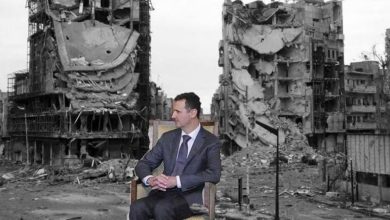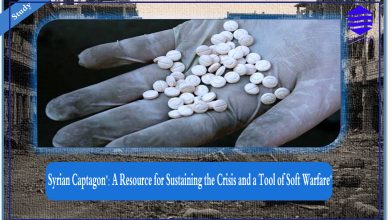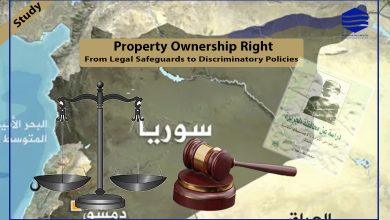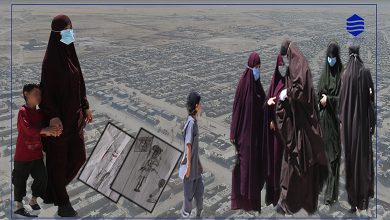
The Kurds and the Policy of Atrocities and Massacres Targeted their Cultural and Physical Existence
Introduction:
Nowadays, what the region of North and East of Syria (NES) has seen of occupation, atrocities, and massacres currently, it is just a part of the Turkish state’s culture that is primarily based on denial and obliteration of the other peoples’ culture, and it is an inherited culture from the history of the Ottoman Empire. Nowadays, as if the history repeats itself on this geography, that has never seen stability and security since a long time.
The building of the Nation-State and instilling the nationalism and religious thinking in the region have opened the door widely for practicing the policy of genocide and ethnic cleansing, in which these regimes see its existence based on the denial of the other, i.e. the different. The Kurds constitute a significant example in this context for being exposed to the largest aspects of assimilation and integration policies in the nation-states that have shared their geographical region and have practiced the bloody red massacres against them. The white massacres throughout the cultural and national assimilation, those massacres that have aimed to uproot them from their roots and exterminate them totally and it is still going on.
After the partition of the Kurdish territories in (The Sykes-Picot Agreement) and the international agreements upon the newfound nation-states that followed, the regimes of these States, together with Iran had proceeded in cracking down, in brutal and bloody way, on the Kurdish uprisings that demand the rights of the Kurdish People. Furthermore, its governments had issued decrees and institutions that installed the border of these states. They had considered the Kurdish territories as part of the territories of these states and the Kurdish people are part of their ethnic nationality. They confirm that there is no minorities or ethnic nationalities that differ from the ruling nationality (Arabic, Turkish, and Persian), and these policies were the most difficult periods of the history of this people.
The situation in Syria was not different from the other parts, in which the Syrian State has never entered the natural context by any means since the 1920s. It seems to remain until today, it is being ruled by martial law, and the lack of institutional system based on social reconciliation. Even a significant proportion of the Kurds are not citizens, i.e. they are not recognized legally, and the rest of them have the lack of access to any legal, cultural, economic, administrative, or political rights. In other words, the situation of the Kurds in Syria is more underdeveloped than the status of a colonization, as well as, in the rest of the states that have shared its territories.
The Kurds and the Policy of a Genocide and Ethnic Cleansing in the Nation-States
The atrocities, massacres policy, and demographic change operations aim to genocide and ethnic cleansing. Within this context, Mr. Abdullah Ocalan believes that the Kurds are the most significant, clear, and scandalous examples of these policies for being the largest victim by the assimilation and integration policy in the Middle East. The Kurdish had to obey all the cultural policies that were being practiced upon him by Nation-States; otherwise, he was exposed to all kinds of genocide. Beginning with unemployment and starvation, to the ethnic cleansing, he had to choose, either to surrender in exchange for opening the doors for his promotions to higher positions or to resist and bear its burden that might amount to a genocide.
The phenomenon of genocide and ethnic cleansing is being implemented in several ways; mainly: the physical genocide, and the cultural one, it aims for the complete extermination for the peoples and minorities and all religious, sectarian, and ethnic groups.
The physical Genocide is generally being committed against the cultural groups that usually their cultural status is higher than the culture of the ruling group. Perhaps the Armenian and Jews Genocide are the most significant examples in this regard. Whereas the cultural genocide is being committed against the peoples and sectarian and ethnic groups that are, frequently, in an underdeveloped and vulnerable position compared to the nation state’s culture and its ruling elite. In which the former seeks to elimination of the existence of those groups and its eradication, according to specific programs and policies. All state’s institutions contribute in that, and on the top, the educational institutions throughout the assimilation of the targeted groups inside the culture and language of the ruling elite and the nation-state, this is how the cultural genocide is considered the most dangerous forms of the ethnic cleansing for having the deepest impact and the longer-term.
The Kurdish people was one of the most peoples that were being exposed to the cultural genocide and it is still, all his material and moral cultural values and community-based legacy, along with his both infrastructure and superstructure were being exposed to looting and plundering. While what has been left of these values are at risk of obliteration and decay or it would be exposed to the ugliness, deformation, and forgery policy, the whole point is to push the Kurdish person to abandon these values and to assimilate him into the dominant nation-states’ crucible. For those who did not respond to this treatment, they would have to confront the physical genocide policy, therefore, the Kurds are at the list’s top of the most miserable people for being exposed to the most examples of the tragic genocides that is to work on making to be obliterated.
There are some aspects that we are going to review, related what the Kurds have been exposed to. Such as massacres, ethnic cleansing operations, and demographic change.
In Turkey
Nowadays, Turkish practices in both fields of genocide and ethnic cleansing against the Kurds based on the historical background, and they are not limited to the time being, that is why we must go back a little to the history of this State’s massacres against the Kurds.
The Ottomans had exposed the Kurds to exile, displacement, and deportation. They were blockading cities, burning orchards, and villages with its inhabitants and executing its leaders in order to impose the forced displacement on its people throughout the activation of Turanism tendency in the Ottoman State.
Turkish Regime’s ethnic cleansing practices have continued also in the Republic Era. The Treaty of Lausanne on 24 July 1923 has shaped the border of the Turkish Republic that Mustafa Kemal Ataturk had been able to define the concept of the minorities and its nature, especially those who do not convert Islamic Region, who are Christianity, Judaism, and others smaller and few in number. That is how the Kurdish existence had been denied as a different nation within the new Turkish border, and a racial concept has been imposed adopting on the Turkish race as the only basis of the Turkish State, and considering all the nations who existed on “the Turkish Land” as Turks in blood, language, culture, and heritage. That is how they denied any other none-Turkish linguistic groups, they were deprived to express their identity, ambitions, and their national languages; they were prevented from opening, schools, universities, publishing houses, and so on….
The Turkish Governments have adopted four main methods in its genocide and ethnic cleansing operations since the emergence of the modern Turkish State, which are:
- The bloody repression against the Kurdish Uprisings.
- Disarming all the Kurds regardless of their participation in these uprisings.
- Settlement of the Kurds all over the country, so that they would be the minority, and replace the Turks in their regions instead of them.
- Issuing unfair and arbitrary resolutions.
Many resolutions that had been passed by “the Turkish Grand National Assembly” against the Kurds in the 1920s of the last century, and they are still working until these days, especially both resolutions No.1097 and 1178 in 1927. They state on the displacement and deportation large numbers of the Kurdish families to the west of Anatolia. The resolution No.1505 in 1929 that included taking control on the lands of the Kurdish leaders under the pretext of false slogans that is (distribution of the lands on the peasants of eastern Anatolia. As well as, the Resolution No. 2510, which aimed at distracting and scattering the Kurds inhabitants in the northern Kurdistan in a way that their proportion does not surpass 10% of the total population in any state of this country. Ataturk did not stop working on his “Turkification” policy, which he had endorsed to suppress the Kurds and undermine their rights and had issued a resolution in 1932 that stated on, “prevent individuals, who are speaking another language rather than Turkish, from rebuilding their villages and towns.”
There was another resolution that Ataturk wanted to use in order to strip the Kurds from their identity, which is the resolution in 1934 that endorsed to conceal the recognition of Aghas(lords) and Elders, and changed the name of “Dersim” city, which means “ the bronze gate in Kurdish” into “ Tuncali”, which means “the bronze land” in Turkish.
All these resolutions, beginning from “the East’s Reform Resolution” that dated in 1925, to “the compulsory settlement resolution” in 1935, were aimed at the elimination of the Kurdish existence, since, it has not only targeted the Kurds in practically and regularly, but it was aimed at the elimination of their existence, too. Based on the role that says, “If you would like to stay alive and wealthy, you should abandon your identity”! which is not too far from what Erdogan has said: “the Kurds either accept humiliated life, or they will be buried under the ground”
The Kurds had experienced the most severe kinds of violence during the uprisings that they have conducted. The phenomena of displacement and the execution of their leaders were the most methods that had been adopted concerning the Turkish response. They had experienced a severe repression and violence in the uprisings of Kocgiri in 1920 and Sheikh Saeed’s Revolution in 1925.Turkish Army has killed all who were suspicious in their involvement in the Revolution of Ararat (Agri) in the late spring of 1927. The death toll has raised to 3000 Kurdish, 1550 persons had been beheaded in the Zilan Valley massacre only, and 200 villages had been burned in the Argish Region. As well as they had displaced the participants’ families in the uprising, Zilan Massacre was one of the worst crimes of the Turkish State, in which the citizens of 72 villages in Zilan Region had been exterminated. They had bombarded the region by aircraft, the population had been put together and burnt due to the uprising, the victims’ numbers had reached to more than 15 thousand persons, and two thousands persons had been considered among the missing.
Seyed Reza along with 11 others of his fellows had been presented to the military court that issued death penalty against them; the judgment was implemented on 18 November 1937. The Turkish Army had started to follow genocide policy, destruction of the houses, and displacement of population, in which it had bombarded the region using Air Force, Artillery, and heavy weapons. As well as horror stories about the brutality of Turkish soldiers such as cutting mothers’ bellies and pregnant; killing babies; rape against women and children; some cases of collective suicide, in which many women and girls had thrown themselves into the Monzor River to avoid being raped.
Turkey lived one of its hard times following the coup of 1980, Amed(Diyar Bekir)Imprisonment is one of the dark evidence on that period of the Modern Republic, in which it had practiced inhuman methods against the prisoners, and the Northern Kurdistan had become an open prison for Kurdish People.
Hundreds of thousands of civilians displaced after 4 thousand villages had been burnt in the 1990s of the 20th century that aimed at their displacement, the region had been emptied from its real owners, in addition to the crimes that had been written “against anonymous cases”, which surpassed more than 17 thousand cases.
In Iraq
The Kurds of Northern Iraq had experienced atrocities and massacres, successive Iraqi governments proceeded the Kurds’ displacement, especially under Al-Ba’ath Party Government. It had conducted the largest operation of the sinful ethnic cleansing against them between the 1970s-1980s by the displacement of Feyli Kurds to Iran on the pretext that they are Iranian. As well as it had conducted Arabization campaigns in the Kurdish regions within the ethnic cleansing policies since the 1960s, in order to change the demography of Northern Iraq(South of Kurdistan), 600 Kurdish villages had been burnt in 1978 and 1979 and 200 thousands of Kurds had been displaced to the other parts of the country.
The Anfal Campaign, the Great Migration, and Halabja massacres were the most horrific ethnic cleansing all over the Middle East region and they were as horrible as the Hiroshima and Nagasaki massacres.
In Iran
The situation was not different in Iran from what it was in the rest of the States; the Regime of Shah executed Qazi Muhammed and his fellows who were the founders of the Kurdistan Republic(Mahabad), as well as killing and terrorizing the Kurds in their residential areas. Moreover, the Regime of Velayet-e faqih (Guardianship of the Islamic Jurist) continued in practicing genocide and ethnic cleansing system against the Kurds, Khomeini’s fatwa (Advisory Opinion) is a good example in this regard, which had been issued after months of taking control over the reign. It was referred to (Jihad against infidels) and claimed the lives of more than 10 thousand of civilians, furthermore, the series of the executions and daily arbitrary arrests are still going on against the Kurdish activists to this very day.
In Syria
After Al-Baath Party took over the power and announced itself as the leader of the State and Society since 1963, it had started the denial policy throughout maintaining on unfair decrees against the region. It began from the Statistics Process in 1962 that had been issued by the “Secession Government”, which has left a significant number of the Kurdish people without Identity Card (ID), under the name of foreigners and non-registers. As well as the implementation of the Arabization project, which has been submitted in stages by Mohammed Talib Hilal, which was aimed at demographic change in the region, before Al-Ba’ath Party is controlling the reign of the country. Afterwards, the project of building settlements followed for those who affected by the Euphrates’ Dam project and housed them in the Kurdish villages under the name of “land reform”. The Regime took over a fertile lands and distributed it on who have been called “submerged people”, furthermore, imposing the starvation policy on the Kurds in order to be disciplined, imposing surrender, and then a total humility and submission to the Regime. Based on this plan, the Regime began issuing its supportive decrees and one of these decrees was the decree No. /49/ in 2008 concerning real estate or what is being known as Expropriation Act and the population of the border areas, i.e. the adjacent areas had been prevented from buying and selling properties and register their own properties throughout this decree. This act had just been implemented on the Kurdish Society in practice, i.e. the Kurdish person has the right to sell properties and lands, but he does not have the right to buy it, and even he had been deprived of the right of repairing or any change on his own house even in urgent cases by the Regime.
We cannot fail to mention, the Kurdish uprising in 2004, which was based on the abovementioned decree, in which the Al-Ba’ath Regime began to abuse the Kurds in their regions after the Kurdish protests spread in the Kurdish cities. Beginning from Qamishlo city to all the other cities, including the neighborhoods that are inhabited by the Kurds in metropolitan, such as Damascus and Aleppo, which claimed dozens of the lives, as well as, thousands of detainees.
An unfair economic Acts were issued; especially in agriculture field because the region is agricultural. It is being the lifeline for its people, not to mention, the lack of any kind of support in this field. Even the State began to control the livelihood of the population throughout cracking down on everything, preventing farmers and peasants to sell their crops to whomever they want, but they were forced necessarily to sell their corps to the State’s treasury, which was being taken with the cheapest prices.
The cultural genocide was being practiced against the Kurds in their areas. They were prevented to practice their cultural rights; they were prevented from the right of naming their children with the Kurdish names; as well as preventing learning their mother tongue language; even speaking it in its official institutions; imposing the Ba’athist educational system that refusing the existence of any non-Arabic in Syria.
The purpose of all these unfair procedures against the Kurdish people is the integration and assimilation of the Kurds in the Arabic crucible and forcing the majority of the people to migrate to the center and its surrounding provinces, to crack down on them and force them to do all kinds of works that undermine their dignity.
The Kurds were capable to maintain the security of their areas after a violent battle against terrorist groups; firstly, Al-Nusra Front, and then ISIS, throughout the Syrian Crisis. However, the Turkish State begrudged the safety and stability on the Kurds and began fighting them in accordance with genocide and ethnic cleansing policy. Throughout both genocides: the physical and cultural; it had occupied areas from north of Syria in stages, beginning with Jarablus, Azaz, and then Afrin, to Ras al-Ayn and Tell Abyad, and its announced objective, in public at United Nations,
to change the demography of their areas by a deliberate housing of 3 million of Syrian Refugees along the borderline with Syria and 32 km in depth inside the Syrian territory.
Afrin city was exposed to a massive attack by the Turkish State in 2018; it has inflicted a forced displacement on civilians who were exposed to violence and massacres. According to Rojava Organization’s report, “350 thousand of civilians have been forced to get out of Afrin city and its suburbs, to be distributed on camps that have been built in by the time of their arrival, in Al Shahbaa region, Tal Rifaat, and in the areas of Al Jazeera and Euphrates. While some of them departed to neighboring States or the European States that has led to the displacement of roughly 80% from indigenous inhabitants of Afrin city and around 20% have stayed in a worse situation than a solitary confinement.
The Turkish offensive has led to the killing of dozens of civilians, they were children and women (Tell Rifaat Massacre), and the violent acts are still being committed against civilians and torture is still being practiced against them. Afrin was a model city, which was lived in peace, has turned, under the occupation, to a city that is empty of safety. A group of thieves and mercenaries is now controlling it.
The Turkish President implemented his threats by invading the Northern Euphrates’ areas after he had permission from the American President, Donald Trump, during a phone call, his forces along with its backed-factions crossed the Syrian border, the cities of Ras al-Ayn and Tell Abyad had been controlled, and the areas extended between them.
On one hand, the Turkish Army and its affiliated armed factions had adopted an approach of terrorizing and atrocities against the inhabitants of these both areas and striking the city and its surrounding villages with heavily populated by aircraft and using all types of heavy weapons. On the other hand, the armed elements had taken videos scenes of killing and torturing and posting them on social media networks to terrorize the people and push them to flee from their areas.
The Office of Humanitarian Affairs Organizations in Al Jazeera Canton stated in its report concerning the ramifications of the Turkish occupation in Ras al-Ayn and Tell Abyad that. The martyrs’ number has reached (478) and wounded people have reached to (1070), and the numbers of Internally Displaced People (IDPs) have reached to 300 thousand, more than half of them are only in Hassakah city, and the educational process had been interrupted in 810 schools, resulting in deprivation of 86 thousand students of going to their schools.
Even before the implementation of this operation, the Turkish Army was repeatedly targeting the populations living near the borderline, it was difficult for them to continue their agricultural works in those areas, and it was part of the policy to push the population to leave their areas and to search for their livelihood in another safer places.
The Turkish State in its attempt to repeat the experience of the Lausanne Agreement tries to disregard all international agreements related to an occupation throughout the forced displacement that it is practicing. In the meanwhile, it tries to get international support to begin the process of demographic change in North and East of Syria, which he had announced in an international community, i.e. the hall of the United Nations.
The Conclusion
The policy of genocide and ethnic cleansing is based on the racist background that is primarily related to the concept of distinction. Both Power and Capital constitute provocative factors of it, after promoting the slogans of the superior race, the superior doctrine, and the distinct group, which in turn, pushes party, who is the dominated and in charge of power, to the denial of the other and working to assimilate, integrate, and obliterate him and even to eliminate his existence.
With the absence of solutions; especially the democratic ones, to say the least, authorities conduct a genocide war, but when things develop, for those who lead this war, to obliterate a community from the pages of history, this means a human will necessarily lose his humanity. That is what the leader; Abdullah Ocalan is warning of, “the recklessness of the nationalism of the ruling nation to create a typical national society has become a real catastrophe. The recklessness of the nationalism of the ruling nation of (Turanism) was the reason that has led the local indigenous cultures, such as Hellenic, Armenian, Assyrian, and Kurdish, to the edge of ethnic cleansing.
The ruling authorities had spared no opportunity to crack down on any patriotic national movement that demands the legitimate rights of the Kurdish People in all the States that shared the geography of Kurdistan. They had spare no efforts to abort any attempt of organizing the society, and that is what pushed them to target the Kurdish Society in the four parts with pre-emptive strikes, to be prevented from bringing together and having a power level that would threaten their entities. Which has led to the emergence of the policy of atrocities, massacres, and demographic change.
It can be said that the Turks’ lack of belonging to the geography of this region pushed them to work in accordance with the law of the jungle and the logic of force, and that is what has made them the most ruthless among the other parties in practicing the policy of genocide and ethnic cleansing.
Finally, we see it is time for the United Nations and its paralleled, related, international bodies to recognize the genocides that the Kurdish People have been exposed. Since they are the oldest of the region’s peoples, have lived on his historical land, and have contributed in all development phases of this region from all aspects of intellectual, material, and scientific. However, they were exposed to continuous genocides and still, in which none of them was less than the Armenian Genocide.





